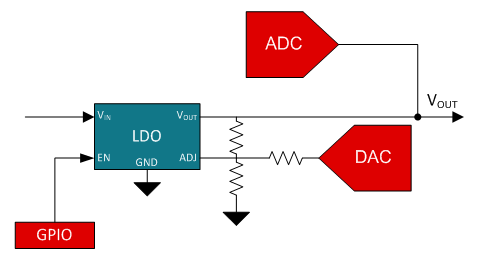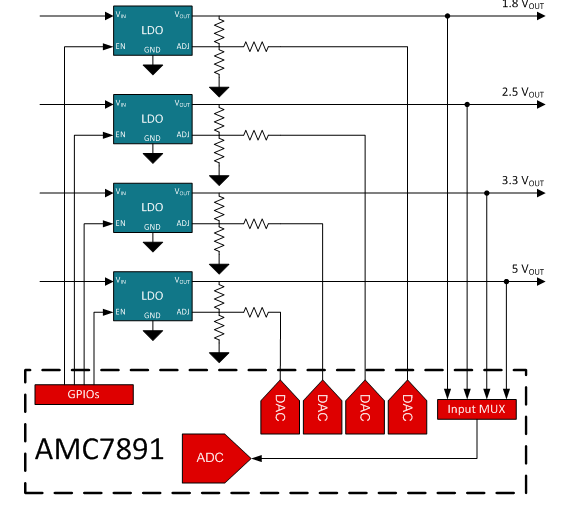In my last post, I talked about how to use a precision digital-to-analog converter (DAC) to margin a voltage regulator like a low-dropout regulator (LDO) or switch mode power supply (SMPS), providing the ability to either precisely tune the output or allow it to swing over a wide range of voltages.
In this post, I will expand upon that idea to build a closed-loop system that, alongside the compute power of a microprocessor, creates an all-in-one analog monitor and control solution for voltage regulators. Let’s return to the example circuit in Figure 1 that I used last time with an LDO and a DAC.
Figure 1: Voltage regulator margining circuit
The DAC shown controls the regulator circuit by sinking or sourcing current – thereby raising and lowering the voltage output of the LDO. You can add monitoring to the circuit by using a precision analog-to-digital converter (ADC) to sample the voltage at the output of the LDO. Additionally, many regulators have an enable pin that you may want to control as well. You can do this by using a general purpose I/O GPIO from the microcontroller. Figure 2 shows these monitor and control devices in the system surrounding the LDO.
Figure 2: Voltage regulator monitor and control system
What would be very helpful is if you could use one device to accomplish the functions of the DAC, ADC and GPIO. Fortunately, TI has a portfolio of analog monitor and control (AMC) devices that integrate all three of these discrete devices into one product.
Let’s use an example where you need to monitor and control four power supplies. A device like the AMC7891 would be great for this application because it has four DACs and more than four ADC inputs and GPIOs. Figure 3 shows how the AMC7891 fits into this system.
Figure 3: A multiple-rail voltage regulator monitor and control system
The AMC7891’s integration enables you to eliminate many discrete devices from the board and centralize the control of the power supplies to just one device.
Here are a few helpful tips when designing this solution into your system:
- SMPS outputs are inherently noisy with the voltage ripple from the switch. Take multiple samples of the output voltage with the ADC and average the samples before changing the DAC code to compensate.
- If your regulator output voltage exceeds the ADC input voltage, you will need to use an external amplifier to add a fractional gain to the output voltage to get the signal within range.
- Put your ADC trace as close as possible to the downstream devices so that you get the most accurate measurement possible at the point of load.
You can visit ti.com/amc to find more integrated precision ADCs and DACs that are similar to AMC7891. TI provides a very broad portfolio of these devices, many having more inputs and outputs for your control system.
Additional resources
- Search for solutions, get help and solve problems in the TI E2E™ Precision Data Converter forum.
- For more resources about working with precision DACs, visit the Precision DAC Learning Center.



